Entrance Hall/Waiting Area
|
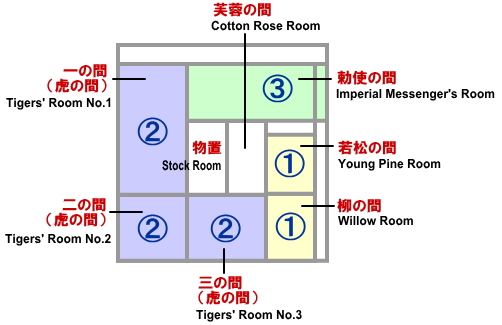
|
(1) Willow Room / Young Pine Room
The rooms, named after the paintings on the sliding Fusuma doors, are located just after entering the Kuruma Yose (or carriage access entrance). They were used by Metsuke (inspectors), who used to verify the identities of visitors.
(2) Tiger’s Rooms or Waiting Rooms
These Tiger’s Rooms No.1 to No.3 decorated with tiger paintings were used as waiting rooms for visiting lords. As there were no tigers in Japan in those days, artists had to use their imagination inspired from the animal's hides brought from overseas.
(3) Imperial Messenger’s Room
Imperial messengers were received here. The messenger used to sit on the upper floor, while the shogun took the lower seat. The paintings were worked by a Kanō School painter.
|
Reception Area / Ministers’ Room
|
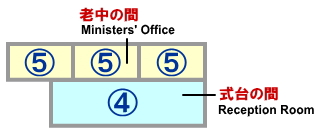
|
(4) Reception Room
The room was the reception area, where Roju (Elders) would welcome visiting feudal lords and received their gifts to the shogun. The Fusuma door painting was made by Kanō Tanyū when he was 25.
(5) Roju Office
Elders or Roju used to work on their papers in these three adjacent rooms. Plain walls and ceilings, as well as less-decorative interiors, show a notable contrast to other luxurious rooms.
|
Audience Area
|
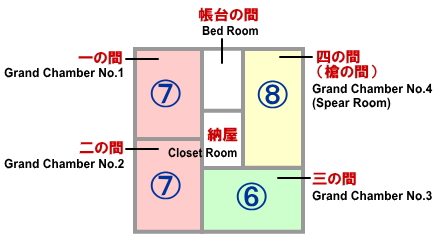
|
(6) Grand Chamber No.3
The room for Tozama daimyo (former rival feudal lords). Tozama lords were those who joined as retainers after the Tokugawa won the battle of Sekigahara in 1600, and therefore, they were least trusted by the shogun.
The Ranma (decorative transom) in the room uses a single 35-cm thick wooden board with elaborated openwork on both sides. The room also features Kugi Kakushi nail covers in hexagonal flower shape, made of gold-plated copper.
(7) Grand Chambers No.1 & No.2
These two chambers were the most important official audience halls in the palace. The interior design uses a warrior version of Shoin style in the Momoyama Period (1568 - 1600). Lavish use of gold and lacquer was intended to overwhelm visiting lords with the power and authority of the Tokugawa reign.
The Shoin style features a Chigai Dana (two-step shelf), a Toko No Ma (decorative alcove), and a Tsuke Shoin (attached writing table). The paintings are works by Kano Tanyu, a prestigious painter of the time. The rooms are historically famous as the theatre where the last shogun Yoshinobu announced his decision to return the reign to the Emperor, in front of assembled representatives of Han or domains.
(8) Grand Chamber No.4
This was the room to store Shogun’s weapons, including spears and swords. A magnificent pine tree and hawks painted by Kanō Tanyū were meant to symbolise the military prowess of the shogunate.
|
Kuro Shoin
|
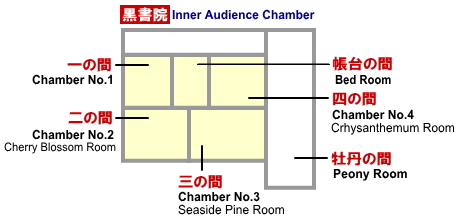
|
Inner Audience Chambers
The area was only accessible by shogun’s inner-circle lords such as Shinpan (relative lords) and Fudai (former ally lords), whom he could trust. Shinpan lords refer to the three families of Owari, Kii and Mito, namely, shogun’s relatives. Fudai stands for those whose families had been shogun's allies and served the Tokugawa family for several generations.
|
Shiro Shoin
|
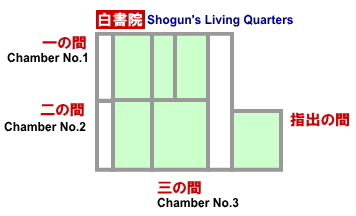
|
Shogun’s Living Quarters
These are the innermost chambers exclusively used by the shogun as his living quarters. The interior decorations, as well as paintings depicting mountains and rivers, create a peaceful and relaxing atmosphere. Entry to these quarters was restricted to female attendants.
|






